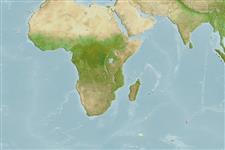Common names from other countries
Environment: milieu / climate zone / depth range / distribution range
Ecología
; rango de profundidad 0 - 200 m (Ref. 4), usually 10 - 40 m (Ref. 4). Temperate, preferred 15°C (Ref. 107945); 25°S - 47°S, 13°W - 99°E (Ref. 107486)
Distribución
Países | Áreas FAO | Ecosistemas | Ocurrencias, apariciones | Introducciones
Southeast Atlantic, Western and Antarctic Indian Ocean.
Length at first maturity / Tamaño / Peso / Age
Maturity: Lm 6.3, range 6 - 7.5 cm Max length : 37.0 cm TL macho / no sexado; (Ref. 4); 27 cm TL (female); common length : 28.0 cm TL macho / no sexado; (Ref. 4); common length :21 cm TL (female)
The total body length of largest specimen ever recorded is 37 cm; and the total body length is 14 to 35.5 cm (male) and 9 to 27 cm (female); and carapace lengths of 6 to 14.5 cm (male) and 4 to 10 cm (female); with an average size of 21 to 28 cm (male) and 19 to 21 cm (female). The specimens from Amsterdam are slightly smaller than those from St Paul Island (Ref. 4). Occurs at depths of 0 to 200 m on rocky or gravel bottom, being most numerous in the kelp zone between 10 and 40 m (Ref. 4). Found clinging to overhangs in deep shade underneath huge rocks; also in caves (Ref. 106858). Confined to oceanic islands and seamounts (Ref. 105202). It is nocturnal and feeds on plants and dead animal matter (Ref. 4). Partially vegetarian (Ref. 105260). Reported to exhibit cannibalism among its deep-water populations (Ref. 105202).
Life cycle and mating behavior
Madurez | Reproducción | Puesta | Huevos | Fecundidad | Larva
May exhibit gynandromorphy (Ref. 10623). Egg-laying starts in May, and ovigerous females have been observed until November, or exceptionally early December. Females are caught from May to October, while males dominate in most catches from November to April (Ref. 4).
Holthuis, L.B. 1991. (Ref. 4)
IUCN Red List Status (Ref. 130435)
CITES status (Ref. 108899)
Not Evaluated
Not Evaluated
Human uses
Pesquerías: comercial
FAO - pesquerías: landings | FishSource | Sea Around Us
Herramientas
Fuentes de Internet
Estimates based on models
Preferred temperature
(Ref.
115969): 5.5 - 15.3, mean 10.2 (based on 4 cells).
Resiliencia
Bajo, población duplicada en un tiempo mínimo de 4.5-14 años (K=0.06-0.11).
Vulnerability
Low to moderate vulnerability (27 of 100).
